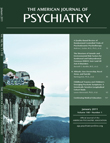The Structure of Genetic and Environmental Risk Factors for Syndromal and Subsyndromal Common DSM-IV Axis I and All Axis II Disorders
Abstract
Objective:
The authors sought to clarify the structure of the genetic and environmental risk factors for 22 DSM-IV disorders: 12 common axis I disorders and all 10 axis II disorders.
Method:
The authors examined syndromal and subsyndromal axis I diagnoses and five categories reflecting number of endorsed criteria for axis II disorders in 2,111 personally interviewed young adult members of the Norwegian Institute of Public Health Twin Panel.
Results:
Four correlated genetic factors were identified: axis I internalizing, axis II internalizing, axis I externalizing, and axis II externalizing. Factors 1 and 2 and factors 3 and 4 were moderately correlated, supporting the importance of the internalizing-externalizing distinction. Five disorders had substantial loadings on two factors: borderline personality disorder (factors 3 and 4), somatoform disorder (factors 1 and 2), paranoid and dependent personality disorders (factors 2 and 4), and eating disorders (factors 1 and 4). Three correlated environmental factors were identified: axis II disorders, axis I internalizing disorders, and externalizing disorders versus anxiety disorders.
Conclusions:
Common axis I and II psychiatric disorders have a coherent underlying genetic structure that reflects two major dimensions: internalizing versus externalizing, and axis I versus axis II. The underlying structure of environmental influences is quite different. The organization of common psychiatric disorders into coherent groups results largely from genetic, not environmental, factors. These results should be interpreted in the context of unavoidable limitations of current statistical methods applied to this number of diagnostic categories.



